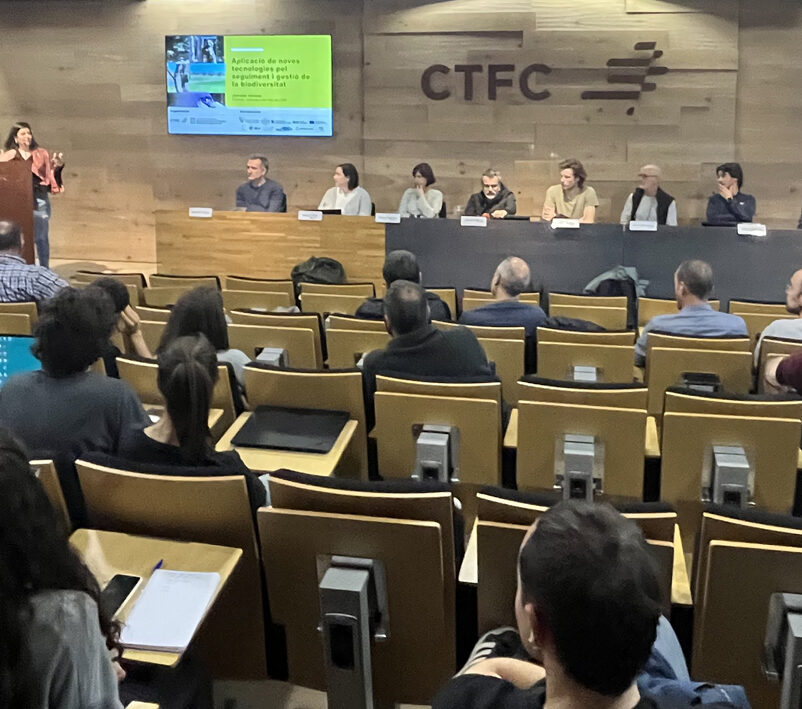On Wednesday, March 6, the technical conference “Application of new technologies for biodiversity monitoring and management” was held at the Center for Forest Science and Technology of Catalonia (CTFC). Organized by the Conservation Biology group of the CTFC, the conference brought together more than 100 participants who were able to learn about the application of new tools by researchers and technicians from scientific institutions throughout Catalonia.
In recent years there has been a general technological improvement that has extended the use and application of new technologies and methodologies that facilitate the monitoring and management of biodiversity. These tools are, among others, autonomous acoustic recorders, devices that incorporate sensors and cameras to obtain images, genetics for species detection, or artificial intelligence recognizers that generate almost immediate results. At the conference, the speakers presented some of the experiences that are currently being developed in Catalonia to share among participants their application and potential use.
The conference was inaugurated by Roser Maneja, CTFC’s research deputy director, who gave the stage to Gerard Bota, deputy head of the Landscape Dynamics and Biodiversity program at CTFC. Bota introduced the subject of the conference by giving an overview of the application of these new technologies and their evolution in recent years, stressing that “the miniaturization of the equipment is allowing us to monitor species that was unthinkable 10 years ago.”
Part of the day focused on bioacoustics, with talks by Eudald Pujol (SCH), Roger Puig (UdG – UB) and Maria Mas (MCNG) who shared their experiences in the study of groups as diverse as amphibians, birds, insects, and bats. And they have exposed, for example, how sound recording can generate information on the impact of disturbances on wildlife.
Later, Delia Serra (AR – DACC) and Jordi Boada (CEAB -CSIC) presented how tools for recording images through drones or ROVS can be complementary to traditional sampling. On the other hand, Arnau Campanera (CTFC) has shown how the combination of photo-trapping and AI can become an immediate detection system for mammals in the Pyrenees.
Jolle Jolles (CEAB – CSIC) and Josep Albarracín (CTFC), on the other hand, explained to the attendees how they have innovated by creating new devices to solve existing needs. For example, with the creation of LOGCAVE, a device to detect the presence of people in caves where bats live through changes in light intensity.
Finally, Bernat Hereu (IRBIO – UB) and Nati Franch (Ebro Delta NP) showed how acoustic telemetry, in the first case, and environmental DNA, in the second, provide basic knowledge to facilitate the management of protected natural areas.
During the final debate, the experts were able to discuss both the opportunities offered by these technologies and their limitations. The participants agreed on the usefulness of these new tools in reducing the resources required both in terms of field work and in the subsequent analysis of the information gathered. This message was also underlined by Ricard Gutiérrez (SFF – DACC) during the conclusion, where he mentioned the key role that these tools can play in the implementation of the catalog of endangered fauna of Catalonia.
This conference is part of the Annual Plan 2024 of technology transfer of Ruralcat of the Department of Climate Action, Food and Rural Agenda and the demonstration projects “AI in the development of applications for environmental monitoring and biodiversity: image analysis and bioacoustics” and “Development and application of innovative IoT devices for monitoring endangered wildlife (IOT4BIO)”. The activity developed in these demonstrative projects has been funded through the Operation 01.02.01 Technology Transfer of the Rural Development Program of Catalonia 2014-2022.

Last modified: 23 October 2024










